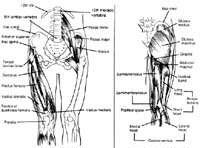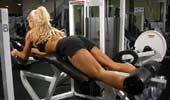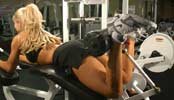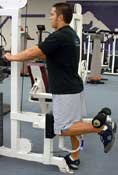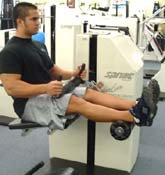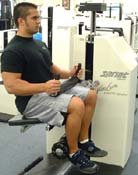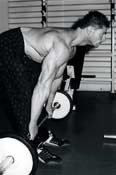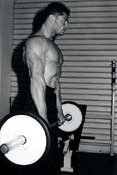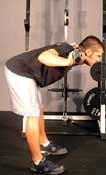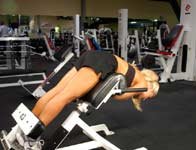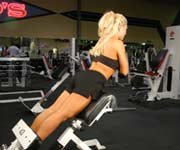In our continuing quest to help baby boomers redefine the process of aging, we are constantly on the lookout for the line that separates a youthful physique from one that is "old." Positive attitude and agile physical movements go a long way to projecting an image of youth; however, these elements are not enough. If you want to portray health and youth, you need to train your entire body.
We go to the gym and can easily spot the over 50, former bodybuilder. He looks lean and muscular when walking around in business clothes, but once he hits the gym in workout clothes the telltale signs of aging appear. Our former bodybuilder still has decent pecs and delts, and even good arms. But, what happened to his legs?
The Forgotten Part Of The Legs
Youthful, baby boomer physiques that are envied can be achieved through hard work that incorporates working all muscle groups for strength, health, wellness and longevity. When working out legs, all too often, hamstrings are underdeveloped, leaving our fellow weight lifters with a less than optimal physique, while at the same time, increasing the risk of future injuries.
The Hamstrings' Priority Status
As a result, this muscle group is often given low priority status in a resistance training routine. This is unfortunate, as hamstrings help provide shape to the leg (important for both men and women), help avoid that telltale old age look of sagging skin and provide strength and stability in the knee and hip joint.
Granted, the quadriceps muscle group will always be stronger that the hamstrings. Dr. Micheal Yessis, in his book, Kinesiology of Exercise, discusses a 3:1 or 4:1 ratio of strength in quadriceps to hamstrings.
However, we are discussing the problems caused by the underdevelopment of hamstrings due to lack adequate training. For our baby boomer readers with the goal to maximize development while minimizing injury, these types of muscular imbalances should be avoided. Granted, the quadriceps muscle group will always be stronger that the hamstrings.
Dr. Micheal Yessis, in his book, Kinesiology of Exercise, discusses a 3:1 or 4:1 ratio of strength in quadriceps to hamstrings. However, we are discussing the problems caused by the underdevelopment of hamstrings due to lack adequate training. For our baby boomer readers with the goal to maximize development while minimizing injury, these types of muscular imbalances should be avoided.
Two joints are involved with the hamstring muscle group, the knee and the hip. The semitendinosus, semimembranosus and the biceps femoris help control the movement of the knee, while the semimembranosus and the semitendinosus help control movement of the hip.
Since the knee and hip joints are involved in so many daily activities and sports, it is important for baby boomers to strengthen the movement and create stability in these joints through ample hamstring development. And for fitness enthusiasts of all ages interested in gaining mass, remember fully-developed hamstrings will allow for increases in quadriceps development.
Prioritize the hamstring muscles in your workout routine. Try working the hamstring muscle group at the beginning of your leg workout while this muscle group is fresh. Starting with hamstrings will provide an environment for maximal growth.
Work hamstrings and quadriceps on different days. Change your routine and plan to work the hamstrings with shoulders, rather than quadriceps for quick developmental gains.
The Importance Of Proper Form
Follow strict form! Two very delicate baby boomer joints are involved here. Over 40, 50 and 60 gym rats usually wear battle scars on their knees and we don't want to add any more scars to the hip joint area. Avoid our pet peeve of bouncing during hamstring movements! No bouncing at the bottom of a stiff-legged deadlift. And don't send the roller pad flying on seated or lying leg curls.
Slow down the movement and contract the muscle, moving at a fairly steady tempo throughout the lift. Avoid too much acceleration at the beginning of the lift that sends that roller pad flying off of your leg and then crashes back down for sloppy lifting form that risks injury without any reward in development.
Our Favorite Hamstring Exercises
For The Lower Hamstrings
- Lying Leg Curls. Try to keep your hips firmly planted on the bench while executing this lift. If your hips are lifting up high on each rep, this is a signal that the weight is too heavy. Be sure to pause at the peak of the muscle contraction.
- Standing Leg Curls. A favorite because you can focus on each individual leg. Bring your leg up behind you as high as possible to maximize the contraction.
- Seated Leg Curls. Take the time to adjust the seat and roller pads properly. A little experimentation for the optimal position will lead to a stronger muscle contraction.
For The Upper Hamstring Area
- Stiff-legged Deadlifts. The king of all hamstring exercises that incorporates glutes and low back into the lift. Remember, the purpose of the exercise is to develop the hamstrings, not to stretch.
So, use enough controlled weight to work the muscle and save the added bounce or stretch for a yoga class. Try shortening the range of motion by only coming back up 7/8 of the way. This will greatly intensify the lift with greater time under tension.
- Good Mornings. With an abundance of machines in today's gyms, Good Mornings are not often seen utilized in a hamstring workout.
However, this is one of those good old exercises that should become a part of everyone's routine as it efficiently and effectively works hamstrings, glutes and erector spinae. Remember to stick your butt out and keep the arch in the small of your back to protect your low back during this lift.
- Hyperextensions. Move slowly through the lift, squeezing the glutes at the top of the movement to develop hamstrings, glutes and low back muscles quickly and effectively. Remember to keep your head in line with your body while going through the movement.
Sample Leg Workout
Quads/Hamstrings/Calves
Warm up for 5 to 20 minutes on the treadmill.
Quads and Hamstrings:
- Leg Press: 1 warm-up set, followed by 2-3 sets of 12-15 reps
- Leg Extension: 3 sets of 12-15 reps
- Squats: 3 sets of 12-15 reps using extremely light weight to focus on form and depth
- Dumbbell Lunge (alternate steps, no walking): 3 sets of 12-15 reps
- Dumbbell Stiff-legged Deadlifts: 3 sets of 12-15 reps
Calves:
- Standing Calf Raise: 1 warm-up set, followed by 2-3 sets of 12-15 reps
- Seated Calf Raise: 3 sets of 12-15 reps
 Click Here For Printable Log Of The Leg Workout!
Click Here For Printable Log Of The Leg Workout!
Diane Fields, Member. Legendary Fitness, LLC.
Richard Baldwin, Member. Legendary Physique, LLC.

Are you interested in receiving our weekly baby boomer newsletter? Click here to be added to the newsletter list. Or, if you have an email account that is not friendly toward bulk e-newsletters, check out our weekly health and fitness newsletter at our website, www.legendaryfitness.com.
All submitted photos become property of Legendary Fitness, LLC; submission shall constitute a grant to the use of your photos and information as we deem appropriate.
Copyright 2005. Diane Fields, Member. Legendary Fitness, LLC. All rights reserved.
The advice given in this column should not be viewed as a substitute for professional medical services. Before undertaking any exercise or nutrition program, Legendary Fitness, LLC advises all to undergo a thorough medical examination and get permission from their personal physician.


